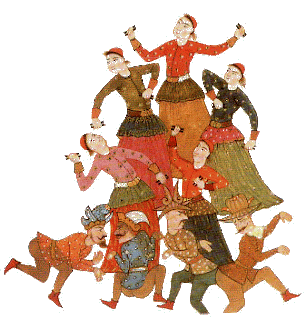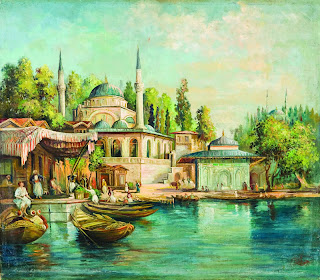A Primer on Turkish Miniatures
Western languages define miniature as a small sized sample of an object. Later, the word has acquired an additional meaning for drawings or pictures of a book. Old Turkish (I am using it very loosely, please do not forget nationalism is a concept of 18th century and onwards; obvious, but often forgotten by many) sources use the words nakis or tasvir for miniature, while the artist is called nakkas or musavvar (let me also note none of them is actually Turkish; they are Arabic).
We find wall paintings and pictures of various figures alongside miniatures among examples of Turkish painting in the Uighur centers of Hoco, Bezeklik, Sorcug in Turfan region dating back to 8th and 9th century. The main theme of the miniatures before the Islamization of Turkish tribes is Uighur princes or princesses and Mani priests. However, many belief systems intersected in the region and rich and diverse (subject matter) miniatures were found. Later works until 13th century were unfortunately lost (it is also worth mentioning that the archaeological research and diggings were scarce due to political instability and hostile environment in the region).
Varka and Gulsah (TPM H.841), a love story similar to Romeo and Juliet but with a different plot, is one of the outstanding examples of 13th century Seljuk painting. The miniatures of the manuscript was drawn by Abdul Mumin whose family had settled in Konya after immigrating from Hoy. The figures representing Turks in Varka and Gulsah closely resemble the figures in the china and pottery of Great Seljuk Empire.
Another one that reached our time is an astrology book presented to Seljuk Sultan Giyaseddin Keyhusrev III, written by Nasreddin of Sivas in Aksaray, in 1271 (Paris, Bib. Nat., P.174). In addition eastern motifs, strong contours and light shading suggest that the artist had seen Byzantine miniatures before.
Another piece that is worth mention is what researchers tagged as "Mehmet Charcoal", originally drawn in Turkestan and found in Mehmed the Conqueror's album (TPM). Drawn on silk and coarse Chinese paper, the miniatures reflect shamanistic world view vividly.
Sadly, the works of Beyliks period, just after the fall of Anatolian Seljuk Empire were also lost. Recent research surfaced a few of them; notably, Dilsuzname: Rose and the Mockingbird of 1455 (Oxford Bodlein Lib.), Hatifi's Husrev-i Sirin (N.Y., Metropolitan Museum of Art, 6927) with his perspective trials, Katibî Külliyati (TPM, R.989), Iskendername (Venice, San Marco Lib.) where Turkmen effect is very obvious come to mind.
15th century onwards, western influence started to make its way. Mehmed's invitation of painters like Gentile Bellini and Constanza da Ferrara had a lasting effect through the students of these artists, especially in portraits. Despite adverse Islamic beliefs of the period, Sinan Bey did make a portrait of Mehmed the Conqueror, relaxed and sniffing a rose in his hand (TPM, H.2153).
Part 2
We find wall paintings and pictures of various figures alongside miniatures among examples of Turkish painting in the Uighur centers of Hoco, Bezeklik, Sorcug in Turfan region dating back to 8th and 9th century. The main theme of the miniatures before the Islamization of Turkish tribes is Uighur princes or princesses and Mani priests. However, many belief systems intersected in the region and rich and diverse (subject matter) miniatures were found. Later works until 13th century were unfortunately lost (it is also worth mentioning that the archaeological research and diggings were scarce due to political instability and hostile environment in the region).
Varka and Gulsah (TPM H.841), a love story similar to Romeo and Juliet but with a different plot, is one of the outstanding examples of 13th century Seljuk painting. The miniatures of the manuscript was drawn by Abdul Mumin whose family had settled in Konya after immigrating from Hoy. The figures representing Turks in Varka and Gulsah closely resemble the figures in the china and pottery of Great Seljuk Empire.
Another one that reached our time is an astrology book presented to Seljuk Sultan Giyaseddin Keyhusrev III, written by Nasreddin of Sivas in Aksaray, in 1271 (Paris, Bib. Nat., P.174). In addition eastern motifs, strong contours and light shading suggest that the artist had seen Byzantine miniatures before.
Another piece that is worth mention is what researchers tagged as "Mehmet Charcoal", originally drawn in Turkestan and found in Mehmed the Conqueror's album (TPM). Drawn on silk and coarse Chinese paper, the miniatures reflect shamanistic world view vividly.
Sadly, the works of Beyliks period, just after the fall of Anatolian Seljuk Empire were also lost. Recent research surfaced a few of them; notably, Dilsuzname: Rose and the Mockingbird of 1455 (Oxford Bodlein Lib.), Hatifi's Husrev-i Sirin (N.Y., Metropolitan Museum of Art, 6927) with his perspective trials, Katibî Külliyati (TPM, R.989), Iskendername (Venice, San Marco Lib.) where Turkmen effect is very obvious come to mind.
15th century onwards, western influence started to make its way. Mehmed's invitation of painters like Gentile Bellini and Constanza da Ferrara had a lasting effect through the students of these artists, especially in portraits. Despite adverse Islamic beliefs of the period, Sinan Bey did make a portrait of Mehmed the Conqueror, relaxed and sniffing a rose in his hand (TPM, H.2153).
Part 2




Comments
Post a Comment